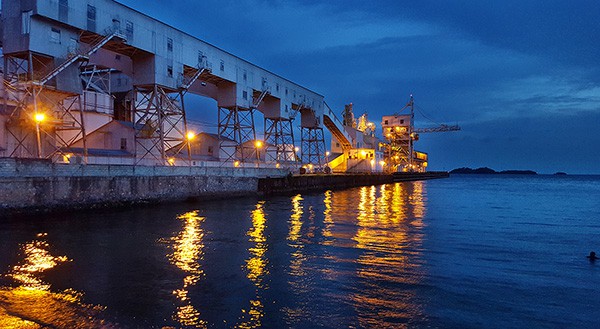
Above: A memorable mistake. I’d shot this photograph of the bauxite loading facility in Carenage and skipped posting it, planning it for another evening. I never returned at the right time during 2015. Photo by Mark Lyndersay.
BitDepth#1032 for March 15, 2016
Some readers of this column might have noticed that I spent a lot of time in 2015 taking photographs with a smartphone.
I’d set myself the task from January 01, 2015 of taking five images and posting one photograph a day using the camera on the phone in my pocket to a website, the results of which you can view here.
The experience was revelatory. These are some of the things I’ve discovered after making just shy of four thousand photographs on a smartphone during 2015.
There is a very real hum around developments within the smartphone space that photographers should be paying attention to, if they aren’t already.
The first concern of any dedicated snapper is about gear and after a slow start, smartphone manufacturers are getting serious about the marriage of computing technology, sensors, lenses and software they are putting into these pocketable devices.
The phone I started the project with, Samsung’s S4, bears only a physical resemblance to the one I completed it with, the S7.
Full disclosure: Samsung stepped in to support the project after the first few months with an upgraded phone as part of a promotional deal connected to the website project.
The new phone had a distinctly faster lens, the files were more robust, the software managing the imaging process was dramatically improved and the device delivered excellent low-light performance in circumstances in which it didn’t seem possible to take a photo with a phone.
I remember running around for a week at dusk photographing well past the golden hour of evening to test the new phone.
Samsung is certainly not the only developer of these devices that is looking to better photographs and more user control over the process as the next distinguishing factor in selling smartphones in a highly competitive market.
I photograph with different combinations of tools and gear, each of which brings a distinct palette to the craft of making a photograph.
Taking photos with a phone is a lot like working with 35mm rangefinder cameras.
The lens is fixed at one focal length, usually medium-wide, so the first hurdle is to get comfortable with what the optics can and cannot do and modify your approach to make the best of it.
It takes a while to get used to handling settings and composition on the phone’s LCD screen quickly if you’re coming from the multi-dial world of the digital SLR, but it’s all part of a different way of working.
The screen you use to view the image is usually distinctly better than the review LCDs on most digital cameras, but it isn’t perfect, and working with images on a smartphone isn’t as accurate or as satisfying as working on them with a fast computer and properly calibrated screen, particularly in sunlight.
In trade, you get a very different way of working with photographs and subjects. It took me a while to remember that I could just reach into my pocket and make a photograph, and the yearlong project was a revelation in prompting me to make that connection on a regular basis.
For a photographer accustomed to producing images on demand to meet need, and that was at the value of the project for me. It’s a fundamental shift and a powerful reconnection with the urge to photograph.
Like most experiments in shifting a long entrenched status quo, it was not universally successful. I’d have great days, delivering several good photographs and have to choose one and others when things were simply barren or I’d been absurdly forgetful, catching myself at nine at night wondering what the hell I could possibly photograph in my office.
A month long effort to explore typography through the alphabet never achieved my aspirations for it and there were days when I really wished I could go somewhere just to get good photos instead of determinedly sticking with mining my regular day.
Those were the moments in the project, a kind of biodome into my photographic process for the project and the arc of my working day, when the viewer finds me on a bathroom break, as it were.
I’ve taken a break from the daily rigor of the 2015/365 project, and I’m still to sift through all those photos to formulate a plan to make use of them.
But the photographic adventure continues on Instagram, where I’d somehow managed to accumulate more than 700 followers without posting a photo. Let’s see what happens when I begin posting some new work there.


